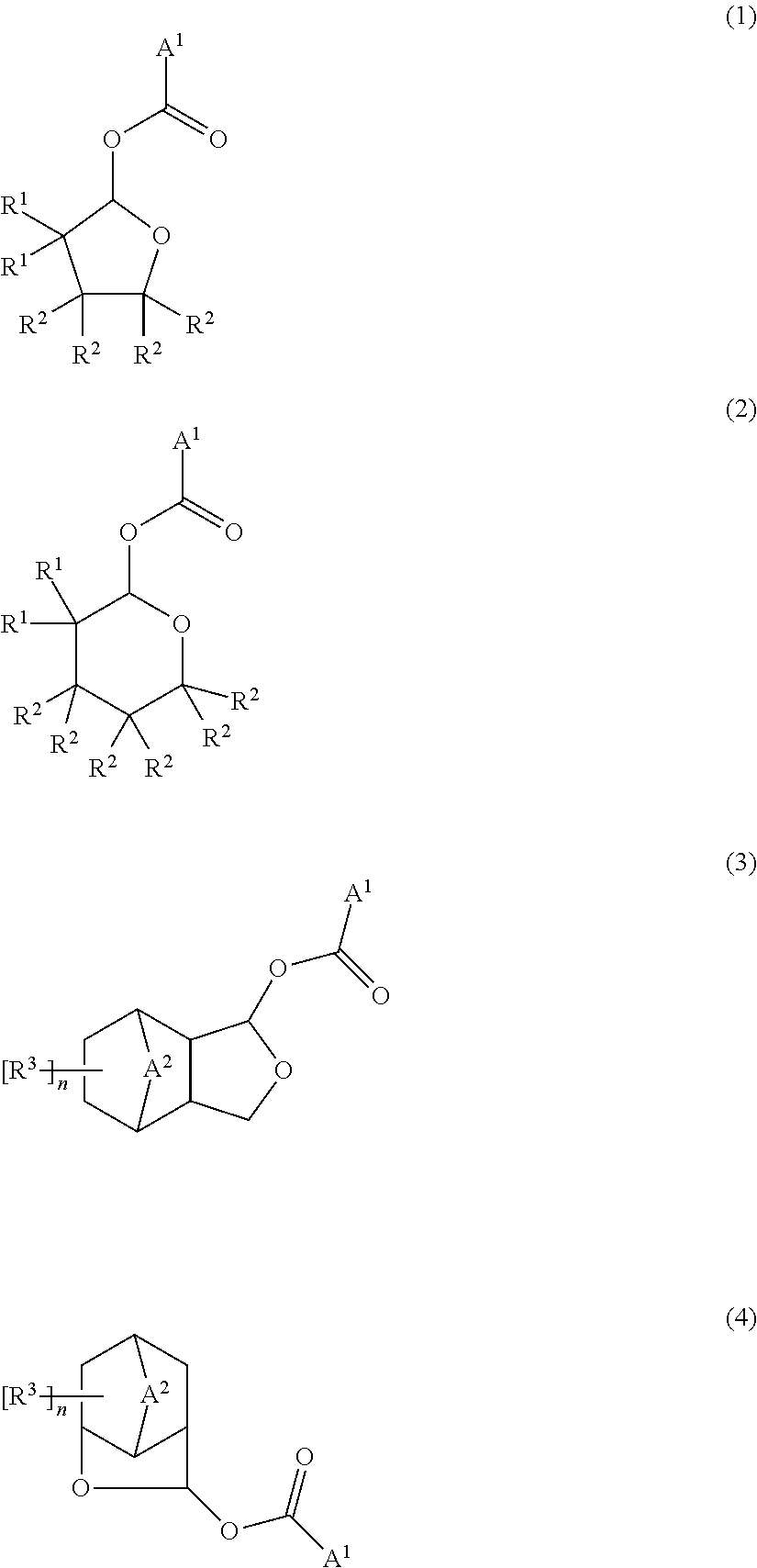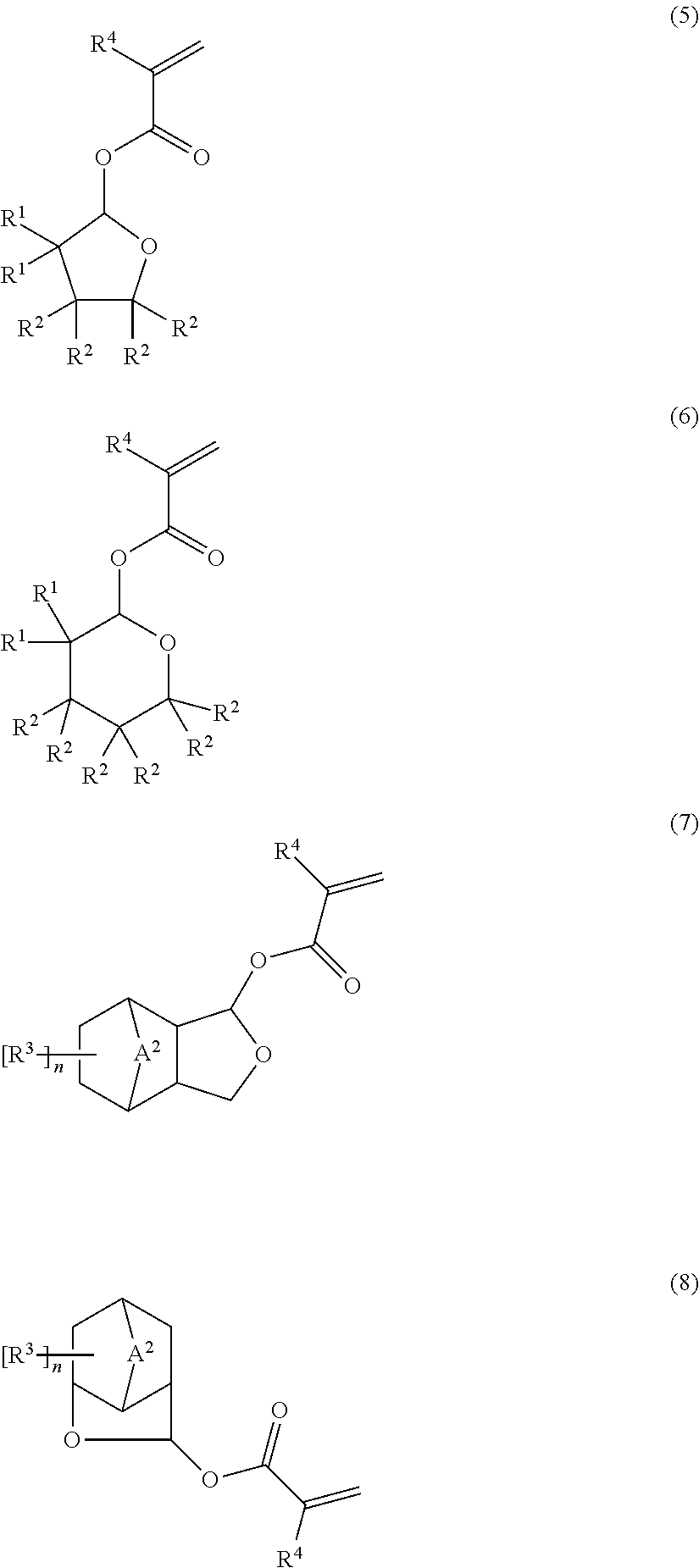Ester compounds and their preparation, polymers, resist compositions and patterning process
a technology of resist composition and ester compounds, applied in the field of ester compounds, can solve the problems of high rate of dissolution in unexposed areas, significant dimensional changes between exposure and heat treatment/development, and no acid labile group is deemed to exert satisfactory performance, etc., and achieves excellent sensitivity and resolution, reduced pattern feature size after development, and improved sensitivity and resolution
- Summary
- Abstract
- Description
- Claims
- Application Information
AI Technical Summary
Benefits of technology
Problems solved by technology
Method used
Image
Examples
synthesis example 1
Monomer Synthesis Example 1
Synthesis of 2-methyl-4-oxatricyclo[5.2.1.02,6]decan-3-yl methacrylate
Monomer Synthesis Example 1-1
Synthesis of 2-methyl-4-oxatricyclo[5.2.1.02,6]decan-3-yl acetate
[0174]
[0175]A mixture of 63 g of 2-methyl-4-oxatricyclo[5.2.1.02,6]decan-3-ol, 42 g of pyridine, and 51 g of acetic anhydride was heated at 50° C. for 5 hours. The reaction mixture was concentrated. The concentrate was purified by distillation, obtaining 74 g (yield 96%) of the target compound.
2-methyl-4-oxatricyclo[5.2.1.02,6]decan-3-yl acetate
[0176]Colorless liquid
[0177]Boiling point: 84° C. / 40 Pa
[0178]GC-MS (EI): (m / z)+=29, 43, 55, 67, 79, 93, 107, 122, 151, 167, 209 [(M-H)+]
[0179]IR (thin film): ν=2966, 2879, 1739, 1479, 1463, 1375, 1241, 1222, 1195, 1116, 1083, 1035, 1004, 973, 952, 925, 908 cm−1
[0180]1H-NMR (600 MHz in CDCl3): δ=1.03 (3H, s), 1.24-1.36 (3H, m), 1.44 (1H, m), 1.52 (1H, m), 1.70 (1H, m), 2.00 (2H, m), 2.02 (3H, s), 2.20 (1H, m), 3.83 (1H, dd, J=27.1, 9.3 Hz), 3.84 (1H, dd, ...
synthesis example 2
Monomer Synthesis Example 2
Synthesis of 4-oxatricyclo[5.2.1.02,6]decan-3-yl methacrylate
[0190]
[0191]The target compound, 4-oxatricyclo[5.2.1.02,6]decan-3-yl methacrylate was synthesized by following the same procedure as in Monomer Synthesis Example 1 aside from using an equimolar amount of 4-oxatricyclo[5.2.1.02,6]decan-3-ol instead of 2-methyl-4-oxatricyclo[5.2.1.02,6]decan-3-ol.
4-oxatricyclo[5.2.1.02,6]decan-3-yl methacrylate
[0192]Colorless liquid
[0193]Boiling point: 81° C. / 11 Pa
[0194]IR (thin film): ν=2956, 2879, 1722, 1637, 1475, 1452, 1403, 1380, 1363, 1326, 1311, 1297, 1267, 1211, 1153, 1116, 1101, 1049, 1020, 1002, 950, 933, 912, 900, 825, 813, 800 cm−1
[0195]1H-NMR (600 MHz in CDCl3): δ=1.25-1.40 (2H, m), 1.43 (1H, m), 1.45-1.55 (3H, m), 1.91 (3H, dd), 2.23 (1H, m), 2.42 (1H, m), 2.55-2.70 (2H, m), 3.89 (1H, dd), 3.97 (1H, dd), 5.54 (1H, dq), 6.06 (1H, dq), 6.20 (1H, s)
[0196]13C-NMR (150 MHz in CDCl3): δ=18.12, 22.41, 23.55, 39.07, 40.28, 41.99, 43.92, 52.36, 68.79, 100.58,...
synthesis example 3
Monomer Synthesis Example 3
Synthesis of 3-methyl-2-oxaspiro[4.5]decan-1-yl methacrylate
Monomer Synthesis Example 3-1
Synthesis of 3-methyl-2-oxaspiro[4.5]decan-1-ol
[0197]
[0198]To a mixture of 40 g of ethylmagnesium bromide and 120 g of tetrahydrofuran was added a mixture of 50 g of cyclohexylmethylenecyclohexylamine and 50 g of tetrahydrofuran. The resulting mixture was stirred for 2 hours under tetrahydrofuran reflux conditions. Thereafter, 21 g of propylene oxide was added under ice cooling to the reaction mixture, which was stirred for a further 12 hours at room temperature. Then 30 g of acetic acid was added to quench the reaction, followed by ordinary aqueous workup, obtaining 74 g of a crude product, 1-[(1-cyclohexylimino-methyl)cyclohexyl]propan-2-ol. To 74 g of the crude product were added 16 g of acetic acid, 400 g of hexane, and 280 g of water. The mixture was stirred at 50° C. for 12 hours. The reaction mixture was then subjected to ordinary aqueous workup and distillation...
PUM
| Property | Measurement | Unit |
|---|---|---|
| size | aaaaa | aaaaa |
| temperature | aaaaa | aaaaa |
| temperature | aaaaa | aaaaa |
Abstract
Description
Claims
Application Information
 Login to View More
Login to View More - R&D
- Intellectual Property
- Life Sciences
- Materials
- Tech Scout
- Unparalleled Data Quality
- Higher Quality Content
- 60% Fewer Hallucinations
Browse by: Latest US Patents, China's latest patents, Technical Efficacy Thesaurus, Application Domain, Technology Topic, Popular Technical Reports.
© 2025 PatSnap. All rights reserved.Legal|Privacy policy|Modern Slavery Act Transparency Statement|Sitemap|About US| Contact US: help@patsnap.com



